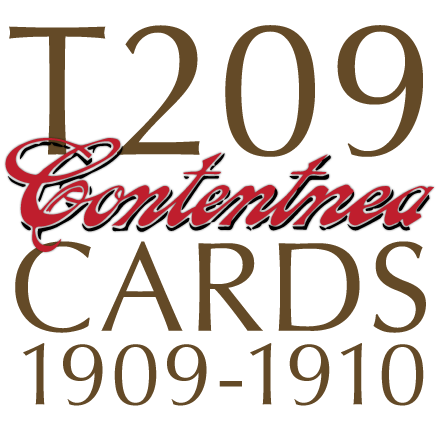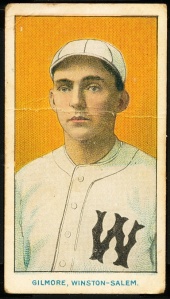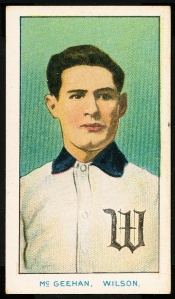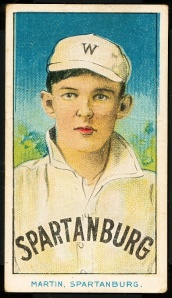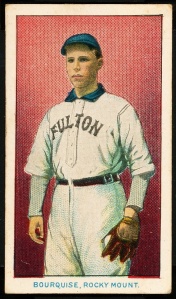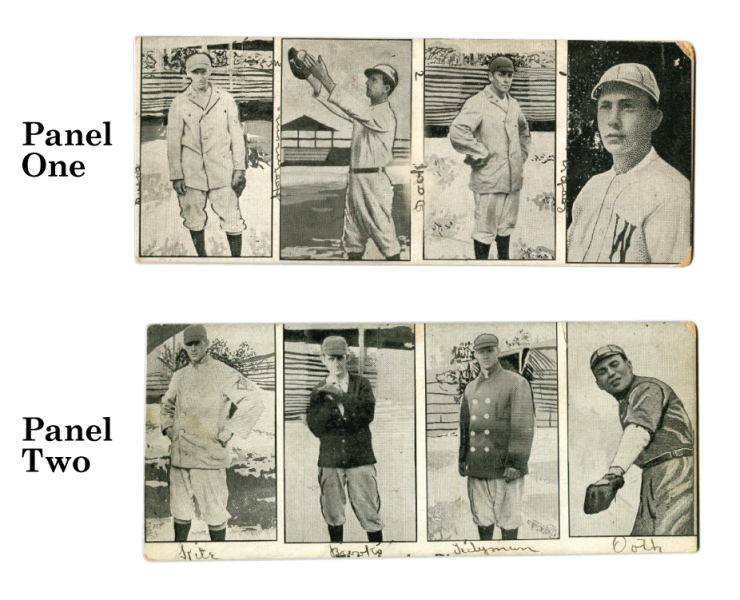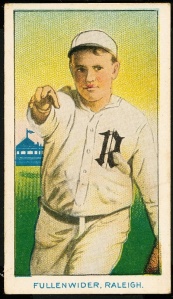 Series One of T209, which has commonly been dated to 1910, consists of sixteen player cards with images reproduced in color lithography on cards that measure 1 9/16” X 2 11/16.”
Series One of T209, which has commonly been dated to 1910, consists of sixteen player cards with images reproduced in color lithography on cards that measure 1 9/16” X 2 11/16.”
The backs note that the players are from “the Virginia [League], Carolina Association and Eastern Carolina [League].” The Eastern Carolina League (Class D) was made up of North Carolina teams from Fayetteville, Goldsboro, Raleigh, Rocky Mount, Wilmington, and Wilson. The Carolina Association (Class D) included three North Carolina teams (Charlotte, Greensboro and Winston-Salem) and three from South Carolina (Anderson, Greenville, and Spartanburg). Twelve of the sixteen players in Series One are identified with teams from the Eastern Carolina League, the remaining four from the Carolina Association. There are no players from the Virginia League (Class C). The manufacturer’s error in listing a league that was not represented by player cards is the first of many hints that the series was put together in haste.
For this reason, and several others, we believe that Series One was issued late in the 1909 season. With one exception, all the players portrayed in Series One are documented as appearing for the indicated teams in that year (SABR, Baseball-Reference.com). In contrast, only four of the sixteen played for the team listed on their cards in 1910, while eight played for different teams, and four did not play at all (See Chart A here).
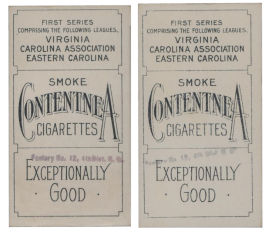
The Contentnea Series One backs identify the cards as being from the “First Series.” Unlike most other card issues of the period, they were not printed with the factory number of the cigarettes packed with the cards, as required by law. This apparent oversight was subsequently corrected by the use of a hand-stamped “Factory No. 12, 4th Dist. N.C.” Such hand-stamped overprints have been found in black (very light impression) and purple. There are unconfirmed reports of green-stamped backs.
In this period all advertising inserts in tobacco packages sold for public consumption were required by law to list tax information: “the manufacturer’s registered factory number, district, and State shall appear upon each card, coupon, or certificate.” (IRS Regulations 8, p. 26) Every tobacco card from the era has this printed information on the card’s back, except for T217 Mono and T209 Series One. The backs of some T209 cards are hand-stamped “Factory No 12, 4th Dist. N.C.,” in black or purple ink. The manufacturer’s haste to get cards into circulation may have led to the omission of the federally mandated information. But once this was pointed out, perhaps by federal agents, the remainder of the cards were hand stamped.
Why such great haste to issue the cards? Erwin-Nadal sought to exploit the collecting craze precipitated by the large-scale issue of baseball player cards in cigarettes produced by the American Tobacco Company. As Scot Reader has established (Inside T206), the release of T206 in early 1909 “set-off a veritable frenzy among American boys.” The management at Erwin-Nadal was clearly aware that cards depicting “Baseball Men” were prized.
As a small regional company Erwin-Nadal could not compete with ATC, which had cornered the market on the major leagues and well known minor league players for their cards. But by depicting players from nearby teams, they might capture a greater share of the local market.
Players of Series One
Since Contentneas were produced in Wilson, the teams represented in Series One (Goldsboro, Greensboro, Raleigh, Rocky Mount, Spartanburg, and Winston Salem) function like spokes on a wheel for the regional sales area, with Wilson as the hub. The Wilson team won the 1909 Eastern Carolina League championship, drawing large crowds to its home games. So it makes sense that Wilson has the greatest number of players represented in the set (five), followed by Raleigh (four), and Goldsboro and Greensboro (two each). Four of the sixteen players in the first series, Red Booles, Davey Crockett, Daniel McGeehan, and Joe Walsh played briefly in the major leagues.
Even with the growing compilation of early minor league rosters and statistics in recent years, at least four cards in Series One are mysterious. Hub Gilmore (at left) is listed with Winston-Salem on his card although he actually played for Wilson. The logo on his shirt is the same as his Wilson teammates and is different from the “WS” logo of Winston-Salem. Dan McGeehan’s card (shown at left) correctly lists him with Wilson, but his collared uniform and the logo are different from the rest of the Wilson team. “Legs” Martin (below), listed with Spartanburg, wears a cap bearing a “W,” not an “S.”
Much stranger still is Bourquise, (below) identified by the caption as being with the Rocky Mount team, but shown in a uniform labeled Fulton. Lew Lipset proposes that “Bourquise” should actually be “Bourquoise,” but no player listed by either name appears in the SABR database. A player named Burke appeared in 39 games with the Rocky Mount team in 1909, but to misread or mishear such a common name into the exotic “Bourquise” seems a pretty unlikely scenario. Across the minor leagues during the 1909 season, the closest surname belongs to second baseman Dave Bourquen who played fifty-two games for the Bridgeport Orators in the Class B Connecticut State League, but no evidence points to him as the mysterious Bourquise.
The Fulton team name on Bourquise’s Jersey adds more mystery, since there were only two Fulton teams in this era, but neither was active in 1909. The Fulton, Kentucky team in the Class D Kentucky-Illinois-Tennessee (Kitty) league didn’t start playing until 1911, and the Fulton, New York team (Class D Empire State League) existed only from 1905-1907. In other words, the issuers of T209 managed to include — as one of only sixteen — an unknown player from a nonexistent team!
Possibly Bourquise, like the other three, did play in the Carolina Association or Eastern Carolina League, but in their Contentnea photos each is incorrectly identified, and is wearing the cap/jersey of a school, town, or semi-pro team for which he had previously played. Keith Olbermann suggests how this might have occurred in a Baseball Nerd post about Series One player Phifer (Phi) Fullenwider, a University of North Carolina graduate (1908). Phi hooked on with Columbia of the South Atlantic (SALLY) league in 1910, and because of his 26-9 record with Columbia in 1911 he was invited to the 1912 New York Giants spring training camp. Although he never played in the majors, he is pictured in a Giants spring training photo wearing his UNC sweater. Olbermann points out that this was not uncommon “for `bushers’ to report to the big leagues—and apparently to bring their uniforms with them.” (Baseball Nerd, 18 December 2009)
Player identification is also hampered by the fact that during this era team rosters were constantly changing. Players were released, and players from different regions and leagues were added. Many of the players and leagues are undocumented in historical records, thus it’s not hard to imagine mistaken identifications of the players’ names. Is it possible that “Bourquise” was a late-season addition and never actually played with the Rocky Mount team, yet somehow made it into the T209 set? Though his inclusion may never be fully explained, it again suggests that Erwin-Nadal was working in tremendous haste to assemble and issue its first cards.
Production of Series One
Economics seem to have dictated the decision to limit the first series to sixteen players. The manufacturer would have wanted to emulate the successful ATC cards, but color lithography was expensive and required multiple passes through a printing press. To keep costs down Erwin-Nadal probably used a local printer, and printed the cards in multiples of sixteen—four rows across, four rows down—most likely on a sheet of thirty-two cards. Each surface of the printed sheet would contain sixteen fronts and sixteen backs, the different colors applied one press run at a time. At the end of a press run, the printer would flip (turn) the sheets and print the other side, producing thirty-two cards per sheet. This minimized production costs since only one sheet was needed, which could be easily cut into individual cards and inserted into cigarette packages in the least amount of time. While no proof sheets exist to corroborate the printing process, two panels containing poses used for Contentnea cards have surfaced that suggest this:
Each panel contains four player photos printed horizontally, with hand-written names identifying each photo. Panel One contains two players (Hoffman and Cooper, players number two and four) who are depicted in the pose found on the Series One card. The other two are Doak (player number three), probably Fred Doak who appears in Series Two (in a different pose), and an unidentified player. Panel Two includes Lynchburg’s Al Orth in his T206 pose (player number four). But because Orth was depicted in ATC’s series, Erwin-Nadal perhaps decided not to invade their turf. Tidyman (player number three) could be either Vincent Tydeman (Wilmington) or John Tiedemann (Norfolk) both of whom are depicted in Series Two (in different poses). Brooks (player number two) could be pitcher Harvey Brooks (Wilmington/Lynchburg), not depicted in Series Two, while the other photo is of an unknown player.
The panels are not proof sheets. If these were proofs, first printings used to check color and image registration, the player’s name/team affiliation would appear as it does in the final version. Further, the paper used for the panels is heavier than the stock used for the finished cards. They are probably photographer sample sheets, used to show a prospective customer player poses that could be used on cards. Each player’s name was most likely written by the photographer to identify the player.
The fact that two players from the second series (Photo Series) also appear on the panels suggests that another series of player cards was planned from the beginning. Once they had decided to create a regional set, the manufacturers sought to get a few cards into the marketplace before the end of the 1909 campaign, knowing that more time could be spent creating a regionally comprehensive second group for the following year.
Michael Peich & Tim Newcomb
Old Cardboard (Issue #27, Spring 2012)
Revision: March 2014
Endnotes & Acknowledgements:
1. Jamie Hull suggested valuable resources regarding the tax codes governing the tobacco industry during 1909-1910, and public records regarding Erwin-Nadal’s formation.
2. Keith Olbermann generously shared his research on T209 and early tobacco card players. Baseball Nerd is available at: http://keitholbermann.mlblogs.com.
